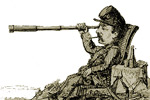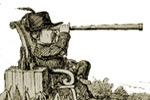

 Go Back |
 MIS-INFORMATION |
 Spies & Scouts |
| In April, 1863, Union Army General Joseph Hooker's signalmen intercepted a message that indicated the Confederates were reading measages sent using the Federal Signal Code. The messages the Federals sent was unenciphered, their only protection being the guarded secrecy of the alphabet being used. Months earlier, Federal signalmen reconstructed the Confederate alphabet, which was also being used without encipherment. The Confederate's ability to read the Federal's traffic, however, did not put them on the same capability level with their enemy, for they virtually eliminated the value of their accomplishment by revealing it in their own messages. The Federals knew the Confederate code and also the fact that the Confederates knew the Federal code; the advantage here was that the Confederate's were kept unaware of the fact that their code had been compromised. Colonel Albert J. Myer, the Union army's chief signal officer,reacted to this news by quickly implementing the use of a simple alphabetical shift cipher, in which the letters of the alphabet were substituted for each other, these pairings changed daily and were repeated on a weekly basis. It was not a complicated system, and could be reproduced in the field from memory of his Signal Officiers. By doing so, the Federals began using seven complete codes, the Confederates could reconstruct them using the same method as the origninal, and Myer was completely aware of this weakness, he also knew that it would take weeks, if not months, before the Confederates would intercept enough messages for their cryptographers to recognize the pattern and letter pairings. Myer took this calculated risk, in place of a more complicated system, which would have been difficult to implement on what might be the eve of a major battle. His judgement would later be confirmed, no evidence has been uncovered that the Confederates penetrated these codes. By September, the Federals implemented a cipher disc to encipher messages, a much more secure form of cyrptology than the Federalshad used up to that time.
As not all messages were of importance, Myer directed that some messages still be transmitted using the original code system. He ordered that these messages should be sent and to include information that would lead the Confederates "to believe that we cannot get any clue to their signals" and that the messages should include "imaginary military movements". One problem with Myer's plan was that as the Confederates encountered enciphered messages, when they suddenly intercepted an unciphered one, including troop movements, they would suspect that they were an attempt to decieve. General Butterfield had an answer to this problem, he came up with a way for his Chief Signal Officer, Captian Samuel Cushing, to transmit without the lack of encipherment being suspicious. The text of his message, sent at 4 p.m. on April 13th, read as follows:
To avoid suspicion, Butterfield avoided using the official message format of "address-text-signature". His message simulated signalman to signalman chatter, a well known occurance among the soldiers. The ruse worked, the next day the signal officers on the army's left intercepted a confederate message which began: "Dispatch received from Yankee signal flag" and continued to repeat the false message in full, although contained a few "garbles" [errors]. The following day, Federal signals intercepted their hoax message again being repeated by the confederates. This plant got the attention of Lee, who wired Jones in the valley:
Fitz Lee's brigade, which was on a foraging mission to the north, was called back to resist the federal move, which had already been moved to Culpeper from the lower Rappahannock. Stuart moved his own headquarters to Culpeper from Fredericksburg. Stuart did not believe the Federals were headed to the valley, but his belief of their intensions were also wrong, he felt the movement was "a feint to cover other operations," a return of the Army of the Potomac to the Richmond front. Lee at first derived a theory not far from Hooker's downriver plan, and agrred that Stoneman's movement was a feint but one "intended to draw us to the upper Rappahannock, that Fredericksburg might be seized, and the bridges across the river rebuilt." As this theory wore away, concern about Stoneman and the valley set in, and he kept Stuart in the upriver position. At one point he thought the enemy was "rather fearful of an attackfrom us than preparing to attack." Even into late April, he was still discussing with Stuart the idea of Stoneman crossing the Blue Ridge. Butterfield had hoped the message would cause Stuart to expect a cavalry advance westward, rather than the attended southward approach, but only knew that this message had been forwarded to Lee's headquarters. Stuart's position opposite the Federal cavalry could have been taken solely by Stoneman's move, without regard to the confederate signalmen's intercepted message. After a weeks time had past, they were still there. This effected Hooker's plan, not only for the cavalry, but the whole grand maneuuver plan. Stuart had left a huge gap, twenty miles wide, facing Kelly's Ford. This signalmen's ruse was not the only length to which Hooker went to surround his troop movements to secrecy, he also requested of the postmaster in Washington to hold up the mail to the army for twenty-four hours. The reason being: "very urgent...as you may readily imagine". |
 Go Back |
  |
 Spies & Scouts |